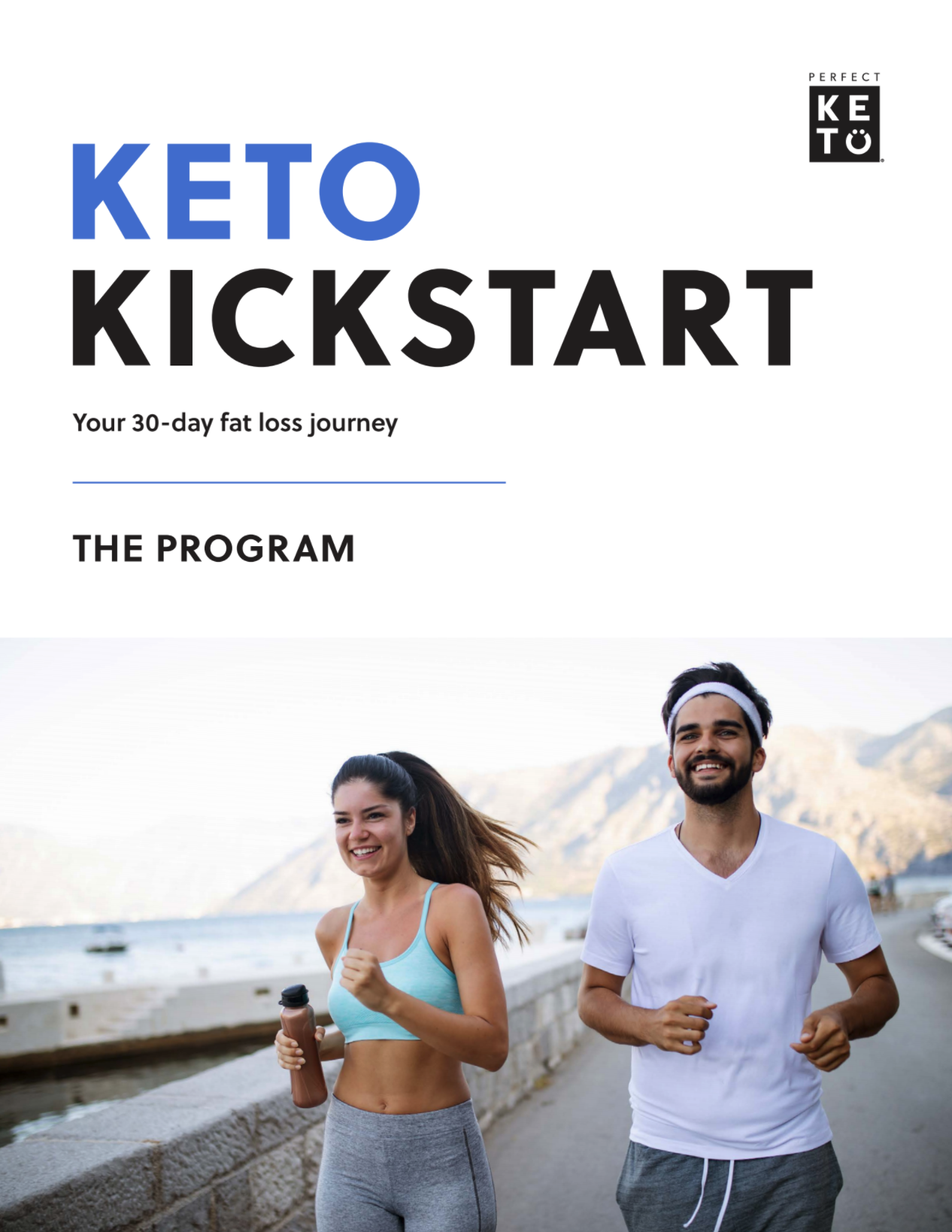Good news, cheese lovers: yes, you can enjoy dairy on a ketogenic diet!
It’s not only a delicious snack, cheese may be the extra boost of fat you need to hit your daily macros.
But before you go overboard on that meat and cheese plate, eating dairy on keto comes with a few words of caution, which I’ll talk about today.
I’m diving into everything you need to know about dairy and keto, including what dairy options to reach for and which ones to steer clear of.
I’ll also touch on how a ketogenic diet affects lactose intolerance and whether organic options are really worth the investment.
Here’s a sneak peek of what’s in store:
To start, I’ll answer the biggest question racing through your mind:
Is Dairy Okay on a Ketogenic Diet?
First, it’s important to understand that not all dairy is created equal.
- Some options are loaded with carbs while others are filled with the protein and fat combo you need to stay in ketosis.
- If your choices are too high in net carbs, you’ll need to work harder to fit them in your macronutrient goals.
- Consuming dairy can also be tough for some people to digest. You may experience unwanted side effects and health problems in the form of stomach upsets, bloating, sinus issues, acne, and joint pain if your body doesn’t digest it properly.
- Plus, when you pick up pasteurized instead of raw milk, you’re also missing out on all of the good bacteria that can help you properly digest dairy with ease.
So, even if certain dairy is keto-friendly, if you’re noticing any of those pesky symptoms, it may not be right for you.
Another reason to consider taking it easy with dairy is the simple fact that, as a highly processed food, it’s easy to go overboard.
While it can be the perfect boost to complete your day and round out your fat intake, dairy has the potential to ruin your calorie and macro goals in one small snacking session.
To keep all your dairy consumption within keto limits, let’s go over a few ground rules first.
Keto and Dairy: Here’s What You Should Know
To take full advantage of dairy on keto, you should choose organic (see why this matters later), raw, full fat options instead of anything marked fat-free or reduced fat
As you’ll see in the next section, 1% and 2% dairy products are actually loaded with carbs. Since the fat is removed and sugar is added, you’re left with two things you don’t want on keto.
But just because you have the green light on certain dairy, doesn’t mean you should throw caution to the wind here. Take it easy by only enjoying dairy in small quantities.
Remember: While it’s high in protein and fat, dairy also comes at a high calorie cost too. A single serving of cheese can average around 100 calories.
You should also adjust for the extra protein boost.
If you pair dairy with another high protein source, you’ll may risk going overboard with your macros if you’re not careful.
The Top Seven Keto Dairy Choices
These keto dairy choices are safe to eat and should be added to your diet in moderation.
#1: Butter
Organic, grass fed butter is one of the best reasons to stay on keto. It’s delicious and packs 12g of fat for zero carbs in a single tablespoon serving[*].
Hello, fat bomb.
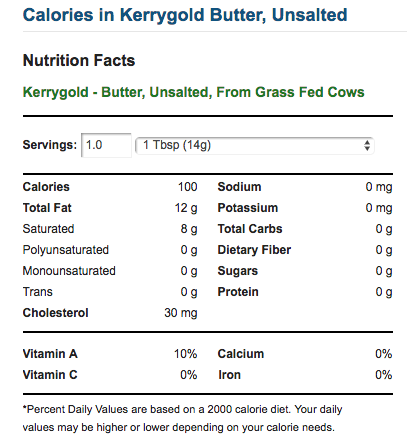
Again, if weight loss is your goal, the only reason to limit your butter consumption is due to calories. A tablespoon of butter may not seem like much for 100 calories.
The next option on our list takes butter one step further.
#2: Ghee
Ghee is clarified butter. All that means is that the butter has been cooked longer to remove the water and milk solids.
The remaining mixture is pure butterfat and ideal for any keto-er.
Take a look at the nutritional breakdown of this store-bought version[*]:
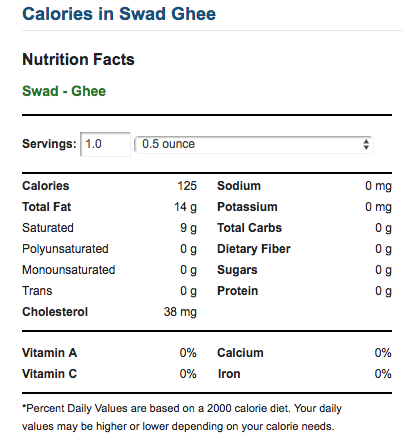
It has 2g of total fat more than butter for an extra 25 calories (and still zero carbs)
Unlike butter, ghee is really easy to make at home.
Simply purchase a high-quality, grass-fed butter and melt it in a pot on your stovetop.
Ghee also boasts another added benefit over butter: 25% more short-chain and medium-chain triglycerides (MCTs). In comparison, butter only has 12-15%.
These types of fats are easily digestible and readily available as an energy source in your body, which means you may sneak into ketosis faster using them[*]
Now’s the tough part: choosing between butter and ghee.
Fortunately, you don’t have to decide; both options work well with keto, just like the next item on our list.
#3: Heavy Whipping Cream
If you’ve made (or are making) the switch from sugar-laced lattes to keto coffee, you’re probably dealing with some major sugar withdrawal issues.
One way to create a keto-safe replica is to use a dollop of a heavy whipping cream in your coffee
Just whip up your heavy cream to stiff peaks (you could add a bit of vanilla extract and no-carb sweetener too) then add a tablespoon to your coffee and sip on your new frothy decadence.
Heavy cream can also be used in savory recipes like this bacon, egg, and cheese breakfast casserole or keto dessert recipes to add an extra layer of creamy goodness.
The next few dairy items also share that same creamy characteristic.
#4: Fermented Yogurts, Greek Yogurt, and Kefir
When you think of fermentation, you probably associate it with lots of sugar. After all, that’s what used to feed the bacteria or yeasts
And since sugars aren’t keto-friendly, you may be thinking fermented foods are off limits. That’s only partially correct.
See, when foods are left to ferment, microorganisms of bacteria or yeast spend their time feeding off the sugary carbs.
This helps to eliminate the bad bacteria while leaving the good ones intact (probiotic perks, FTW!).
So while a large amount of sugar may be used to create a fermented food, most of it has already been eaten away by the bacteria.
In some cases, such as an unflavored kombucha, you’re left with less than 3g of carbs and 1g of sugar per serving, making it a swell option to enjoy in keto.
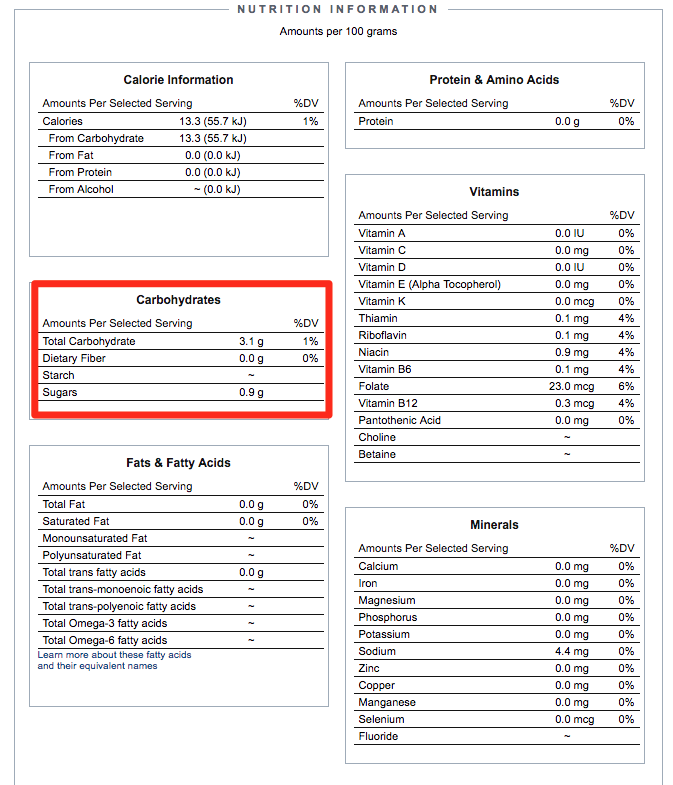
However, this comes with a major caveat.
As with most yogurts and fermented drinks like kombucha and kefir, buyer beware.
Many varieties on the market are packed with unnecessary added sugars, which makes it harder to find a good keto option. You’ll need to pay attention to labels here and do your homework.
Look for unflavored, full-fat yogurt and kefir (read: no fruit on the bottom).
Whenever the fat gets removed, as with 1% or 2% varieties, you can bet that added sugars are taking its place.
And the exact same thing goes for plain, unflavored, full fat Greek yogurt.
If you can find one that doesn’t have too much sugar per serving, you may get 18g of protein and 10g of fat.
This challenge may be too difficult if your grocery store carries a very limited assortment. But our next keto-approved dairy option is pretty universal.
#5: Sour Cream
While the tang of sour cream may taste similar to Greek yogurt, there’s almost zero carbs in full-fat sour cream so it’s actually a much better option.
Sour cream is made by fermenting regular cream with certain types of lactic acid bacteria.
You probably won’t want to add nuts and raspberries to a bowl of sour cream in the AM like yogurt, but it lends a creamy consistency that’s perfect for dips, thickening sauces, and using as a carb-free condiment to top taco soup, for example.
Our final two dairy options are probably what you’ve been waiting for.
#6: Hard Cheeses
Cheese lovers rejoice: there are plenty of keto-approved cheeses to choose from.
While a few options are off-limits, most cheeses have very few carbs.
One tip for choosing the right cheese is to look for aged options (think: blue cheese, gouda, or parmesan) since their carbohydrate content will be lower.
This added benefit is thanks to the same bacteria-eating process that works for fermented yogurts and other foods.
Many hard or semi-hard cheeses, such as swiss, colby, and provolone also fall under this lower carb, keto-safe umbrella.
There’s even a few soft cheeses you can snack on or add to your recipes.
#7: Soft Cheeses
Whole mozzarella, brie, muenster, and monterey jack are all perfect cheese choices carb-wise.
Cream cheese, cottage cheese, mascarpone, and creme fraiche are other good options you can eat as is or add to your dishes for a creamier, richer flavor as well.
Want to talk specifics?
Here’s the nutritional breakdown for a 1 oz. serving of some of the cheeses on today’s list:
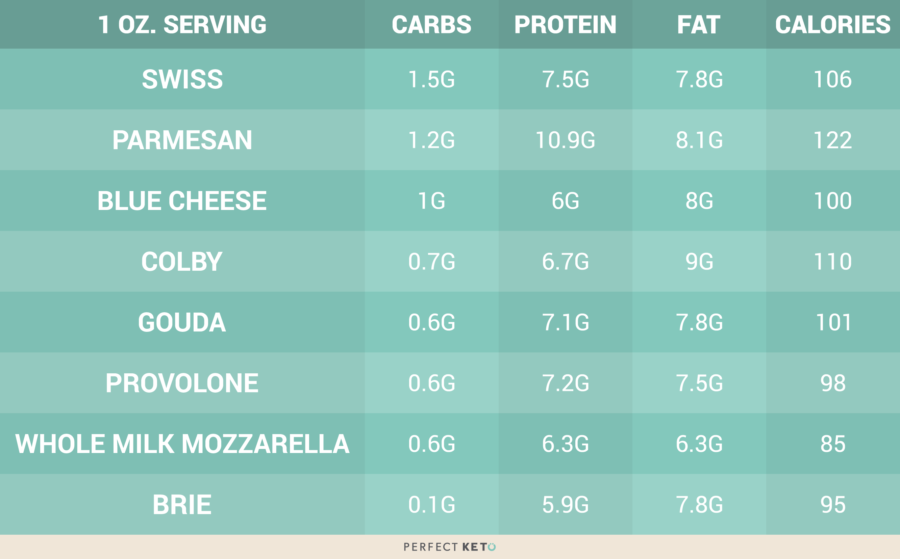
Choosing these seven dairy products will help you stay in ketosis the smart way. But knowing which dairy items should be avoided helps when you’re first getting started with keto.
Three Dairy Products to Avoid When on Keto
You may have noticed that milk wasn’t on the list of keto-safe dairy.
Wondering what gives?
#1: Milk. Low fat, reduced fat, fat free, 1% and 2% milk are all just clever disguises for the fact that the fat has been removed from the milk and added sugars and carbs were pumped back in to create something palatable.
So what about whole, goat, or raw milk?
In the case of goat’s milk, you’ll only reap 8.7g of protein for 10.9g of carbs (yikes!) and 168 calories for an 8 oz glass[*].
Raw milk, while it does have beneficial bacteria, also delivers 8g of carbs, 7g of protein, and 120 calories[*].
As for whole milk, you’re looking at 12.8g of carbs, 7.9g of protein, and 146 calories.
Milk is mostly water and sugar (plus a few other nutrients) so because of that, it’s not going to give you the best bang for your buck macro-wise.
You’re better off with the low carb cheese options that provide the same or better amounts of protein we discussed earlier.
While you won’t need to completely eliminate the next item, you will need to go easy on it.
#2: Half and half. This lab-concocted food choice is half milk, half cream.
What you’re really getting is a mix of sugar with a reduction in fat, two things you don’t want with keto.
Depending on the brand you choose, you could be adding up to two carbs per teaspoon with half and half.
So instead of using this stuff, reach for heavy whipping cream for your coffee or for your recipes without any of the net carbs.
This same advice goes for the next item on the don’t touch list.
#3: Evaporated and condensed milks. While most people aren’t drinking these milks on a daily basis, they shouldn’t be added to your recipes if you want to stay in keto.
Evaporated and condensed milks are simply ones that have cooked down for long periods of time to reduce the water content found in the milk.
These super dense, condensed versions of milk syrup are nothing more than sugar water.
If a recipe calls for one of these milks, don’t sweat it.
Swap this unhealthy choice for an unsweetened coconut milk that has the same thick consistency (thanks to healthy fats) without the extra sugar.
Speaking of alternatives, what happens if you have a dairy intolerance?
Should you avoid the keto dairy combination altogether?
Here’s What You Should Do If You’re Lactose Intolerant
Lactose is a sugar found in milk.
It’s also one of the ingredients that’s difficult to digest in dairy, which is precisely what causes some people to have a lactose intolerance.
Symptoms of this include gas, bloating, cramping, diarrhea, and nausea.
If this is happening to you whenever you consume dairy, there’s a few strategies you can try.
- Stick with hard and long-aged dairy products. These items are much lower in lactose and should be easier on your digestive tract.
- Use Ghee. Ghee (our #2 keto-friendly dairy option) is an ideal alternative for anyone with dairy sensitivities since the milk solids have been removed. Swap ghee for butter in all your meal plans. Try these first two routes before moving on to options #3 and #4.
- Confirm that you’re not dealing with a casein sensitivity. Lactose is the one that gets the bad rep but casein could also be at fault for your stomach upsets.
So if you’re only ruling out lactose, you’re going to continue to experience those same uncomfortable symptoms.
Here’s how to tell the difference between the two:
You’ll get the same gastrointestinal upsets with casein as you would with lactose, but you may also experience an allergic reaction when it comes to a casein intolerance.
Hives, itching, wheezing, anaphylaxis, and facial flushing, which shouldn’t be taken lightly, are all indicators of this.
If you suspect a casein allergy or intolerance, it’s best to get this checked out before trying any of our approved dairy options.
In the end, you may find that your best option is this next one.
- Ditch dairy altogether. You don’t need dairy for keto to work. And if it’s not something that’s sitting right with you, it may be time to cut it out of your life.
For people in this category, coconut or nut alternatives can offer a helpful solution.
Unsweetened coconut, almond, or cashew milk all work well as keto-safe alternatives — as long as you’re choosing unsweetened varieties.
You may also find coconut and almond milk-based yogurts and cheeses, but keep in mind, these tend to be higher in carbs and lower in protein since they’re more geared for a vegan diet.
Then again, you may want to consider this final point when it comes to having a lactose intolerance and going on a ketogenic diet.
How Keto Reduces Lactose Intolerance Symptoms
If you’ve ever experienced a lactose intolerance before, you may be pleasantly surprised to learn that a ketogenic diet can help combat this by reducing those unpleasant side effects.
Often the issue is really with the carbs, not dairy.
So once you eliminate and drastically cut down most of your carbs, you won’t be as affected by the small amount of lactose you’ll find in cheese or heavy whipping cream.
Another helpful tip: Reach for high fat cheeses since they naturally contain less lactose.
Up next, I’ll answer the age old question of whether buying organic dairy is a must on keto.
Do You Really Need to Buy Dairy That’s Organic and Grass-fed?
Keto or not, it pays to spend the extra money on organic, grass-fed dairy products.
For one, conventional dairy products are loaded with harmful hormones, bacteria and antibiotics that will mess with your system.
Not only that, thanks to their overcrowded environments, you’re also getting a dose of stress hormones from conventional dairy products.
Many times, the overprocessed production also strips away valuable nutrients from the final product too.
Organic versions, on the other hand, don’t have these issues.
Organic, grass-fed dairy options are a great source of anti-inflammatory omega 3 fatty acids and CLA, or conjugated linoleic acid, an omega 6 fatty acid that can help promote weight loss and increase muscle strength.
Before you cry wolf that you don’t have the extra cash for organic, grass-fed dairy, consider what else you’re spending your money on.
Now that you won’t be spending $5 a day on sugary lattes, you’ll be able to cover the cost of a few organic items each week.
Trust me, your health, hormones, and energy levels will thank you for making the switch.
They’ll also be grateful for you sticking to keto-approved dairy options only.
Enjoy Dairy on a Keto Diet (In Moderation)
As long as you practice moderation, choose the right sources, watch your carb counts, and account for the added bump in your daily macro and calorie goals, you’ll be able to enjoy dairy on a ketogenic diet.
Just make it a new habit to purchase organic, grass-fed varieties.
And if dairy’s not your thing, or you have a lactose intolerance, you can also find pleasure taking the dairy-free Keto route.
Stick to these easy guidelines and you’ll never have to worry about your dairy obsession ruining your keto experience.
For more Keto recipes like the two I mentioned in today’s article, check out this page.
